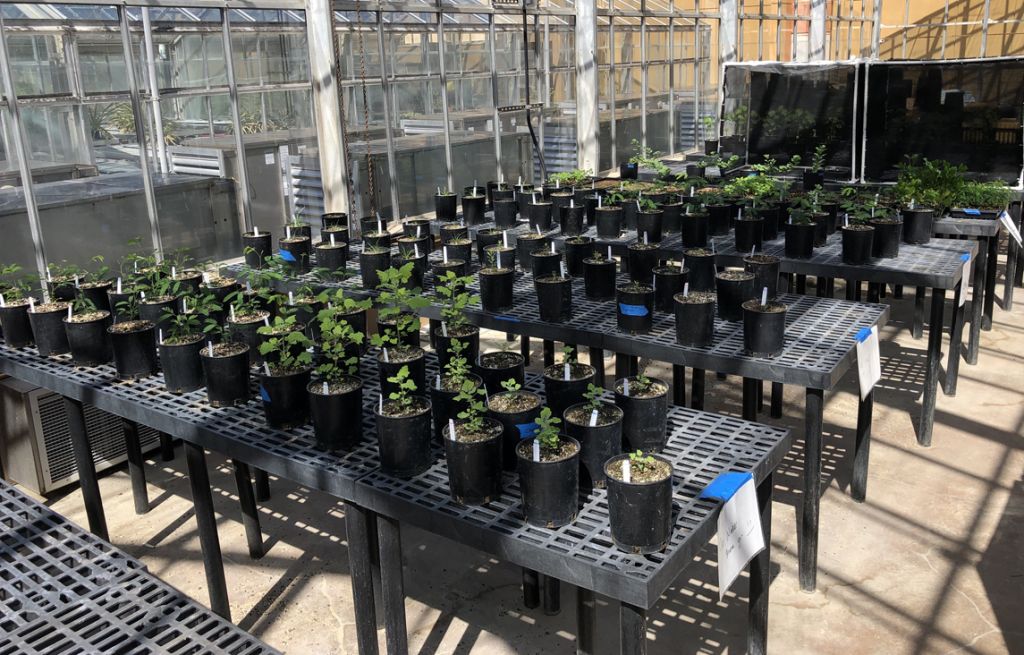In the zone: How salinity research can aid native Hawaiian plants
by Anna H McCormick
The islands of Hawaiʻi are approximately 2,000 miles from the nearest continental landmass, making them some of the most isolated islands in the world. There are approximately 1,400 plant taxa that are considered native, with 90 percent of these plants found nowhere else in the world, making Hawaiʻi a recognized hotspot for biological diversity and a developing botanists dream!

Hawaiʻi also has over 750 miles of combined coastline. The plants found in coastal ecosystems and, in particular, in the supra-tidal zone (the area above high tide) offer significant ecological contributions, providing habitats and food sources for native birds and bees and acting as a frontline defense against approaching weather systems. Coastal communities provide critical contributions to the overall health and functioning of island ecosystems. However, with increasing climate change, these coastal habitats are most exposed to the effects of sea-level rise, with higher salinity exposure, more frequent storm surges, and increasingly severe droughts causing numerous negative impacts. Without concerted conservation efforts, species will most certainly be lost.
Of particular interest to me is that little is actually known about how native Hawaiian coastal plants may tolerate changes in salinity exposure and whether this tolerance is greater in invasive species. Understanding how the ecological landscape might change as we move into a more climatically uncertain future will be important for preserving some critically endangered plant communities. The complexity of these interactions between plant communities and their surrounding environments is what initially peeked my interest in botany.
The Red Queen Hypothesis suggests that continued adaptation is needed for a species to maintain its relative fitness amongst the systems it co-evolves with. Learning about this idea at university forever changed my perception of the natural world. It intrigues me that plants and animals are always undergoing reciprocal evolutionary changes, shifting in response to each other, and that we can examine this process with scientific methods. What fuels my research pursuits today is the urge to reach a better understanding of these systems and their potential real world applications.
I have been very fortunate to have the opportunity as a Hawaiʻi Sea Grant Graduate Fellow to study some rare Hawaiian species in the lab of Dr. Kasey Barton at the University of Hawaiʻi at Mānoa, investigating the plants’ ability to tolerate salinity exposure. Experiments on salinity tolerance are underway with both native and invasive species, and we have, for the most part, observed poor tolerance of native species to seawater exposure. We hope that sharing our results with coastal management groups might assist the conservation of these unique and important plant communities and bring awareness of the importance of preserving floral diversity for ecosystem health, as well as stewardship of the land and natural heritage.

Native plants have had more time to adapt and become naturalized to their environment, so they frequently require less water, fertilizer, and pesticides in their management. This makes them good candidates for conservation practices and out-planting, while also having an obvious economic benefit. Creating native plant gardens also nurtures and sustains native wildlife, providing nectar for rare pollinators, such as bees, butterflies, and moths. The benefits of conserving and protecting native plants, therefore, extend to the surrounding community and additionally help conserve valuable natural resources.
Unfortunately, Hawaiian flora is amongst the most endangered in the world, due to both land development and an overwhelming spread of invasive species, which native plants have difficulty competing with. Through our research, we hope to bring attention to this issue, as well as to help determine which species are most critically at risk from rising sea levels by evaluating their responses to persistent salt exposure. Examining invasive species in parallel will also shed light on how tolerant, and therefore competitive, these species are and the risk they pose to the native flora. As a botanist-in-training, the opportunity to study and contribute to rare plant knowledge in Hawaiʻi has been a remarkable experience, and I hope to continue to add to the knowledge base of botanical studies and the preservation of ecological diversity.

 About the author:
About the author:
Anna McCormick is pursuing a Masters’ degree in the Tropical Plant and Soil Sciences Department at the University of Hawaiʻi at Mānoa and plans to continue research in the plant sciences. She is interested in understanding how environmental properties drive evolutionary trajectories at the population level of plant species and how we can examine these relationships through phylogenetics and genetic analysis.

